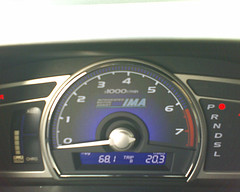
With gas prices rising yet again, the easiest way to keep your driving costs low is to raise your fuel efficiency. If you don’t have the luxury of purchasing a new car (hybrids and manual-transmission cars can get considerably more miles to the gallon, if you do happen to have the luxury) you can still improve your driving habits to get more distance to your dollar. It’s called “hypermiling,” and people have been able to get over 100 miles to the gallon by following these reasonable rules:
- Check the Oil: Doing this every 3,000 miles can reduce engine friction which wastes gas. Check your tire pressure too — properly pumped tires create less friction with the road and are safer in dangerous situations. Be careful not to over inflate them, though, as a blowout is even more dangerous.
- Clean Out Your Car: Every 100 pounds in your car decreases your mpg by 1-2 percent. Good incentive to go on a diet!
- Carpool: Don’t use that last excuse to ditch your friends. Carpooling is one of the best ways to reduce our fossil fuel emissions.
- 5-55-5 Deal: Every 5 mph you go over 55 results in 5 percent less mpg; in fact, you start losing efficiency above 38 mph.
- What a Drag: On hot summer days, refrain from using the air conditioner below speeds of 45 mph; instead, keep all of your windows down to reduce air resistance. On the highway, however, it is best to keep your windows up to reduce drag at fast speeds.
- Drive the Speed Limit: Going slow can save gas. Sit back, put on some music, and enjoy the trip. “Saving” time by speeding endangers everyone, burns through gas, and usually only means you get to start working sooner.
- Don’t Take a Brake: Braking only means you have to speed back up again, which guzzles the most gas. If you are coming to a red light try to keep a steady speed that will time up with the light turning green; friction and wind resistance can be enough to slow you down, so you won’t have to burn out your brakes. In traffic, again try to maintain a constant speed rather than stopping and going. Also, accelerating slowly can make the biggest impact in saving fuel.
- Use the Cruise: Cruise control is a cent-saver any speed over 25 mph; it is more efficient on hills, and is much better at keeping a stable speed than when your foot is involuntarily tapping the pedal to the music.
- Realize the road: You can put your car in neutral when going downhill or approaching a stop. Extreme hypermilers will sometimes turn off their cars when coasting for a while—be careful, though, as this is a very risky measure to save gas and is often illegal.
- Follow the Freight: Drafting is a technique of driving closely behind another vehicle in order to reduce wind resistance. This is most effective on the highway, but also dangerous and illegal in some places. Drafting behind a large truck usually provides the greatest wind reduction, and having to drive at slower truck speeds will increase your miles per gallon, too.
- Un-American Idle: Idling is one of the biggest killers of miles per gallon. Whenever your car is on and you are not moving you are averaging zero miles to the gallon. If you know you are going to be stopped for a while, like when sitting at a long light or waiting for a friend to come out of his or her house, it is a good idea to cut the engine. Before you start up the car, be sure to buckle your seatbelt, adjust the mirrors and seat, and do everything else you need to so that when you start the engine you are ready to go. Turning on the car uses up more gas than idling, but for every 30 seconds to 1 minute of idling it is more efficient to turn it off and restart.
- Carpool Your Errands: wait until you have several things you need to do, then do them all in one trip. Start by going to the farthest away place first, and then stop at each destination on the way back. This will cut down on the number of trips you take, save on gas consumption, and make you feel more accomplished at the end of the day.
- Take the Scenic Route: During rush hour take the longer, less crowded route. It may seem longer, but will get you there in less time and you won’t lose as much fuel or your temper in traffic.
- Track your miles per gallon: If you do not already have a fuel-efficiency computing device, you can calculate your mpg manually. Each time you get gas, fill the tank to the top and reset the trip meter to zero. Then every time you get gas afterward, again fill it to the top and then divide the number miles clocked since your last fill up by the number of gallons you put into the car this time.

